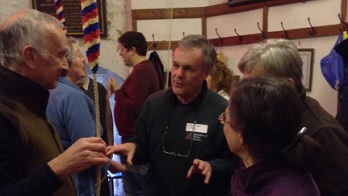M1: 1 Mar 2014 - Speldhurst
Last Saturday 19 participants – some from as far away as Essex – gathered on a cold March morning in the colder church at Speldhurst. After being given coffee and a folder full of information, we adjourned into a small side room – thankfully heated – to both warm up and hear what Graham Nabb had to tell us about ITTS and the teaching of bell handling. Some of the participants were learning to teach and others were attending the Day Course as Mentors.
The course was very professionally delivered using a PowerPoint presentation. The style was fast moving, informal and witty.
It is obvious to most ringers in this area that there are not enough of us about. Many towers in the district struggle to ring for Sunday services. Figures presented were convincing – showing that we are not alone. Bell ringing is a great hobby. It provides an inexhaustible number of interesting challenges – yet we struggle to recruit and retain ringers. Each tower has their own method of teaching new ringers and some are more successful at this than others. As Graham pointed out, we are competing against countless other pastimes – many of which have professionally run introductory courses, follow up programs and schemes to chart achievement. It made me think of the assistant swimming teacher’s course I had attended many years ago, in order to help out with school swimming and the badges the swimmers worked towards. The ITTS Scheme is attempting to provide an organised and structured approach to teaching ringing – trying to drag it into the 21st century.
In the five lecture sessions we learnt about bell handling – breaking up the action into small parts. We learnt how to teach the action. We talked about the importance of learning the correct style; once an action becomes automatic it is much more difficult to change. We covered the different ways people learn, and how this applies to ringing. We were shown exercises to both teach and correct handling – breaking up the action into small parts. Teaching to raise and lower bells was also covered. Although I have been on two handling courses, there were many new ideas to help introduce the learner to the art of ringing in a more gradual and carefully controlled way. I was very encouraged by some of these ideas as my tower has bells which are particularly difficult to handle. Both the weight of the bells and the long draught have previously made me reluctant to teach. I can see that using some of the ideas presented will give me more confidence to teach there. Between the talks, we went up to the tower and practised the exercises on each other. I was encouraged by the idea of moving learners on at a fast pace using dedicated sessions on tied bells – ideally more than once a week. I also liked the idea of teachers getting together and teaching handling together in groups.
We have all been given a user name and password to log on to the Moodle site where numerous resources are available and where we can register our learners. I have already got some ‘victims’ in mind – they just don’t know it yet!
I am looking forward to hearing what Graham has to say about teaching elementary change ringing in the Module 2 Day Course which is currently planned for September.
Janice Byrne

Course Tutor: Graham Nabb
Teaching Bell Handling
Practical advice for teachers, right from the first lesson.